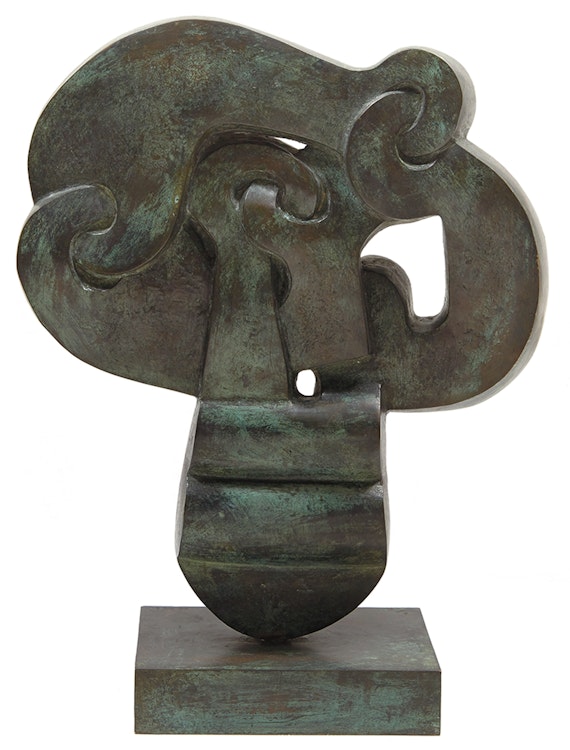Homage to Dr. Martin Luther King by Sorel Etrog

Sorel Etrog
Homage to Dr. Martin Luther King
bronze
stamped signature and edition (5/7) on the base
18 x 13.75 x 5.75 ins ( 45.7 x 34.9 x 14.6 cms ) ( overall )
Auction Estimate: $20,000.00 - $30,000.00
Price Realized $33,600.00
Sale date: June 9th 2021
Felix Landau Gallery, Los Angeles
Private Collection, Ontario
Pierre Restany, Sorel Etrog, London/Munich, 2011, page 77
Alma Mikulinsky, Sorel Etrog: Life and Work [online publication], Art Canada Institute, 2019, page 67
On April 4, 1968, Dr. King was fatally shot while standing on the balcony of the Lorraine Hotel in Memphis, Tennessee. King had travelled to Memphis in support of striking African American sanitation workers and had delivered the now famous “Mountain Top” speech. While working on a bronze sculpture, Etrog had learned of the tragic assassination and decided to execute the work in honour of Dr. King, utilizing twisted knots and links.
Etrog remarks on this emotional exploration through the link in the personified forms noting that “my main concern was not to externalize their agony and pain, but rather to express their internal screams—their mouths and tongues tightly linked together.” The artist effectively trapped the emotional condition of the sitter in an interlocking web of mechanical connections of unreleased screams. Expanding on this exploration, Etrog recalled: “I am witnessing how these past immediate experiences are getting in my new work. I feel certain hardness; the fluid line is being replaced by the links. It gives a more mechanical look. Yet I want to believe that I still speak about the human condition.”
“Homage to Dr. Martin Luther King” expertly captures the internal struggle and contained emotion of the revolutionary figure and all he represents, while expressing the unseen.
Share this item with your friends
Sorel Etrog
(1933 - 2014) RCA
Based in Toronto for more than fifty years, Sorel Etrog was born in Iasi, Romania, in 1933. He is most well-known as a sculptor, but he also illustrated books, painted, and wrote poetry, plays, and films. His sculptures were influenced by his adolescence spent under Soviet rule and an interest in philosophical writings that questioned the nature of post-war society. He was also inspired by his grandfather who was a carpenter. Etrog, along with his parents and sister attempted to flee Romania in 1946 but were caught. His parents were then imprisoned for several weeks. Finally, Etrog and his family left Romania in 1950 and made it to the Sha’ar Aliyaa refugee camp near Haifa, Israel.
While serving mandatory time in the Israel Defense Forces’ medical corps in 1953 he began studying art at Tel Aviv’s Arts Institute for Painting and Sculpture. Inspired by Cubist collage and modernist music, he created three-dimensional paintings, mimicking constructivist reliefs. In 1958, he received a scholarship to attend school at the Brooklyn Museum of Art School.
Upon arrival in New York City, Etrog became drawn to African and Oceanic art due to their expressive shapes and began incorporating these elements into his work. While trying to find gallery representation in New York City, Samuel J. Zachs purchased one of Etrog’s paintings and invited Etrog to spend the summer of 1959 in Southampton on Lake Huron with him. While in Southampton, Etrog created his first wooden sculptures and gained gallery representation from Gallery Moos in Toronto. This encounter inspired the young artist to apply for Canadian citizenship and eventually move to Toronto in 1963.
In his mature sculptural works, Etrog explores spontaneous symbols, primal elements and the relationship between form and symbol. The artist described his art as "tension created by pulling together and pulling apart, with being stuck and being freed, a world of grabbing and holding on and losing hold...bringing shapes together but at the same time giving each an independence."
After immigrating to Canada, Etrog had his first traveling exhibition in 1965. The show began at Gallery Moos, then traveled to New York City, Los Angeles, and Montreal. In 1966, Etrog, alongside Yves Gaucher and Alex Colville, represented Canada at the Venice Biennale. He later received several important commissions, including those for Expo ’67, Montreal; SunLife Centre, Toronto; Windsor Sculpture Garden, Windsor, Ontario; Los Angeles County Museum, and Olympic Park in Seoul, Korea. Before his death in 2014, Etrog’s art was included in a retrospective at Buschlen Mowatt in Vancouver in 2003.
Literature Sources:
"A Dictionary of Canadian Artists, Volume I: A-F", compiled by Colin S. MacDonald, Canadian Paperbacks Publishing Ltd, Ottawa, 1977
Mikulinsky, Alma, “Sorel Etrog: Life and Work,” Toronto: Art Canada Institute, 2018
We extend our thanks to Danie Klein, York University graduate student in art history, for writing and contributing this artist biography.

